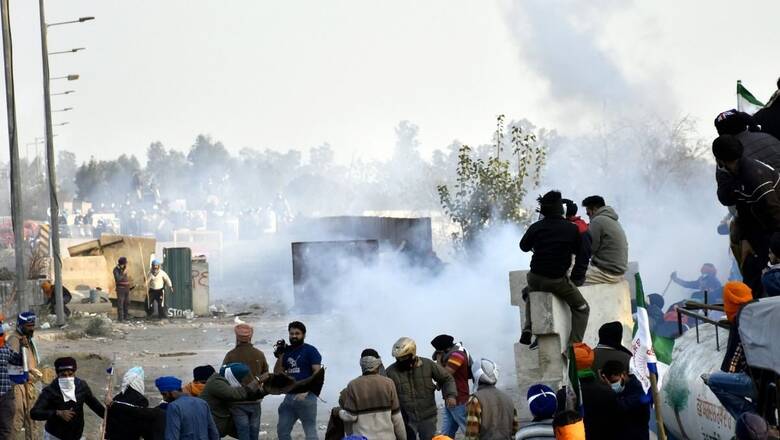
views
Punjab’s farmers are protesting against the Centre, demanding a law guaranteeing minimum support price (MSP) for their crops. But not only do Punjab’s farmers get the highest return for paddy and wheat crops over their cost of production — in short, the most favourable MSP — but they also see the maximum quantity of their crop being procured at that rate than any other state, government reports show.
Sample this: MSP procurement happened for 99 per cent of the paddy crop in Punjab and 74 per cent of the wheat crop in the state in the last season for which data is available, the most recent government report says. The total quantity of rice procured in the last season was the highest in Punjab at 12.3 million tonnes, with the state’s share in paddy procurement being the highest in the country at almost 22 per cent. This is though Punjab accounts for 10 per cent of the rice production in the country. Nearly 74 per cent of the wheat produced in Punjab was procured at MSP in the 2023-24 season, and the state had the highest procurement share of almost 40 per cent in the country. The wheat procurement in Punjab in the latest season grew by 25 per cent.
Doing the MSP maths
The returns for MSP crops for Punjab’s farmers are also the best in the country. These returns are calculated on three basic parameters: Gross Value of Output (GVO), A2, and A2+FL costs. Punjab tops on all three counts when it comes to paddy. “In paddy farming, highest GVO (gross value of output) was realised for Punjab (Rs 1, 36, 636 per hectare). GVO of moong was highest for Punjab (Rs 1,02,047 per hectare); in cotton, the highest GVO was in Punjab (Rs 1,42,239 per hectare). In cultivation of paddy, gross returns over A2 and A2+FL costs per hectare were highest for Punjab at Rs 88,287 and Rs 82,037. In moong, per hectare returns over A2 and A2+FL costs were highest for Punjab at Rs 75,256 and Rs 72,719 respectively. In case of cotton, per hectare returns over A2 and A2+FL costs were highest for Punjab at Rs 89,474 and Rs 81,582,” the government reports say.
Another parameter is the MSP margin over projected CoP A+FL. This is highest in Punjab for both paddy and wheat. Government reports say the highest MSP margins over projected CoP A +FL was in Punjab (152.6%) for paddy as well as wheat (173.5%). For wheat, the highest GVO was realised for Haryana followed by Punjab (Rs 1,01,905 per hectare). Among the top five wheat-producer states in the country, returns for Punjab and Haryana were higher than the all-India average. The per-farmer procurement of paddy in Punjab stands at 11.9 tonnes, the highest in the country. Nearly 184 lakh tonnes of paddy was procured from Punjab on MSP in the last season – the share of beneficiary farmers as a proportion of total farmers in Punjab was over 100 per cent too.
So is it politics?
The face of the current farmer protests, Jagjit Singh Dallewal, has been heard saying that the farmer protests are to “bring down the graph” of Prime Minister Narendra Modi as it has been up since the opening of the Ram temple in Ayodhya. Dallewal has also referred to a “very short window” for this job, alluding to the upcoming Lok Sabha elections. This is now making government sources question if the current protests have the tacit political backing of the Aam Aadmi Party and the Congress.
The current protest is mainly made up of farmers from Punjab, with those from Haryana and Uttar Pradesh not joining in unlike in 2020. The earlier leaders of the farmer protests, like Gurnam Singh Charuni and Balbir Singh Rajewal, are missing from the scene now. The AAP governments in Punjab and Delhi have been backing the intentions of the protesting farmers to enter the capital and protest with no effort to stop them in Punjab or allow the Centre’s request to convert the Bawana stadium into a temporary jail.
BJP functionaries say the answer may well lie in the upcoming Lok Sabha elections in Punjab where AAP and Congress are trying to get on the ‘right side’ of farmers in order to win most of the 13 Lok Sabha seats in the state. With the chances of Akali Dal and BJP down in Punjab, both the Aama Aadmi Part and Congress are in direct competition here and AAP is keen to increase its tally in the state it presently rules.
AAP chief Arvind Kejriwal is also facing the heat from the Enforcement Directorate and has been summoned by both the court and the ED.
“Punjab’s farmers have nothing to protest about. They are already getting the best benefits even beyond the Swaminathan Commission’s recommendations. This protest has political connotations ahead of Lok Sabha elections when all other cards against Narendra Modi have failed,” a senior BJP leader said.


















Comments
0 comment